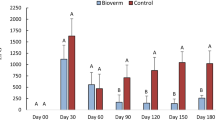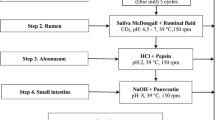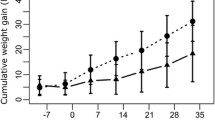Abstract
The viability of a formulation of Duddingtonia flagrans was assessed in the control of parasite gastrointestinal nematodes of cattle. Two groups (A and B) of eight crossbred Holstein × Zebu cattle, approximately one year old, were placed in Brachiaria decumbens pasture. Each animal in group B (treated) received orally 20 g sodium alginate pellets containing mycelial mass of the D. flagrans fungus, while the animals in the group A (control) received pellets without fungus for seven months, starting in March 2005. The egg per gram of feces counting the gastrointestinal nematodes showed a difference (P < 0.05) in the treated group in June, July and August, with reductions of 58% (June), 47% (July) and 51% (August) compared to the control group. The infective larvae recovered in the pastures collected up to 20 cm from distance of the fecal dung in group B differed (P < 0.01) from the larvae recovered in group A. At the end of the experimental period, the animals in group B presented a greater weight gain (P < 0.01) compared to the untreated group (A). The treatment of cattle with pellets containing the D. flagrans nematophagous fungus, at the dose and duration used was effective in controlling the infective larvae of gastrointestinal nematodes of cattle.






Similar content being viewed by others
References
Alves PH, Araújo JV, Guimarães MP, Assis RCL, Sarti P, Campos AK (2004) Aplicação de formulação do fungo predador de nematóides Monacrosporium thaumasium (Drechsler, 1937) no controle de nematóides de bovinos. Arquivo Brasileiro de Medicina Veterinária e Zootecnia 55:568–573
Araújo JV (1996) Interação entre larvas infectantes de Cooperia punctata e fungos predadores do gênero Arthrobotrys, caracterização de isolados de Arthrobotrys e seu uso no controle biológico de nematóides parasitos gastrintestinais de bovinos. Ph. D Thesis, ICB, UFMG, Belo Horizonte, Brazil
Araújo JV, Gomes APS, Guimarães MP (1998) Biological control of bovine gastrointestinal nematode parasites in southern Brazil by the nematode-trapping fungus Arthrobotrys robusta. Revista Brasileira de Parasitologia Veterinária 7:117–122
Araújo JV, Mota MA, Campos AK (2004) Controle biológico de helmintos parasitos de animais por fungos nematófagos. Revista Brasileira de Parasitologia Veterinária 13:165–170
Burke JM, Miller JE, Larsen M, Terrill TH (2005) Interaction between copper oxide wire particles and Duddingtonia flagrans in lambs. Veterinary Parasitol 134:141–146
Chandrawathani P, Jamnah O, Adnan M, Waller PJ, Larsen M, Gillespie AT (2004) Field studies on the biological control of nematode parasites of sheep in the tropics, using the microfungus Duddingtonia flagrans. Veterinary Parasitol 120:177–187
Cox DD, Todd AC (1962) Survey of gastrointestinal parasitism in Wisconsin dairy cattle. J Am Veterinary Med Assoc 41:704–707
Dimander S-O, Höglund J, Waller PJ (2003) Seasonal translation of infective larvae of gastrointestinal nematodes of cattle and the effect of Duddingtonia flagrans: a 3-year plot study. Veterinary Parasitol 117:99–116
Duddington CL (1955) Notes on the technique of handling predaceous fungi. Trans Br Mycol Soc 38:97–103
Faedo M, Larsen M, Dimander SO, Yeates GW, Höglund J, Waller PJ (2002) Growth of the Fungus Duddingtonia flagrans in soil surrounding feces deposited by cattle or sheep fed the fungus to control nematode parasites. Biol Control 23:64–70
Feder WA (1963) A comparison of nematode capturing efficiencies of five Dactylela species at four temperatures. Mycopathologia et Mycologia Applicata 19:100–104
Fernàndez AS, Larsen M, Henningsen E, Nansen P, Grønvold J, Bjørn H, Wolstrup J (1999) Effect of Duddingtonia flagrans against Ostertagia ostertagi in cattle grazing at different stocking rates. Parasitology 119:105–111
Fontenot ME, Miller JE, Peña MT, Larsen M, Gillespie A (2003) Efficiency of feeding Duddingtonia flagrans chlamydospores to grazing ewes on reducing availability of parasitic nematode larvae on pasture. Veterinary Parasitol 118:203–213
Furlong J, Abreu HJL, Verneque RS (1985) Parasitoses dos bovinos na Zona da Mata de Minas Gerais. Comportamento estacional de nematóides gastrintestinais. Pesquisa Agropecuária Brasileira 29:143–153
Grönvold J, Nansen P, Henriksen SA, Larsen M, Wolstrup J,Bresciani J, Rawat H, Fribert L (1996) Induction of traps by Ostertagia ostertagi larvae, chlamidospore production and growth rate in nematode-trapping fungus Duddingtonia flagrans. J Helminthol 70:291–297
Ito S (1980) Modified Wisconsin sugar centrifugal-flotation technique for nematodes eggs in bovine feces. J Jpn Veterinary Med Assoc 33:424–429
Keith RK (1953) The differentiation on the infective larvae of some common nematode parasites of cattle. Aust J Zool 1:223–235
Knox MR, Faedo M (2001) Biological control of field infections of nematode parasites of young sheep with Duddingtonia flagrans and effects of spore intake on efficacy. Veterinary Parasitol 101:155–160
Lackey BA, Muldoon AE, Jaffe BA (1993) Alginate pellet formulation of Hirsutella rossiliensis for biological control of plant-parasitic nematodes. Biol Control 3:155–160
Larsen M (2000) Prospects for controlling animal parasitic nematodes by predacious micro fungi. Parasitology 120:121–131
Larsen M, Nansen P, Wolstrup J, Grønvold J, Henriksen SA, Zorn A (1995) Biological control of trichostrongyles in calves by the fungus Duddingtonia flagrans fed to animals under natural grazing conditions. Veterinary Parasitol 60:321–330
Lima WS (1989) Dinâmica das populações de nematóides parasitos gastrintestinais em bovinos de corte, alguns aspectos da relação parasito-hospedeiro e do comportamento dos estádios de vida livre na região do Vale do Rio Doce, MG, Brasil. Ph.D Thesis, ICB, UFMG, Belo Horizonte, Brazil
Mendoza de Gives P, Flores Crespo J, Herrera Rodriguez D, Vazquez Prats V, Liebano Hernandez E, Ontiveros Fernandez GE (1998) Biological control of Haemonchus contortus larvae in ovine faeces by administering an oral suspension of Duddingtonia flagrans chlamydospores to sheep. J Helminthol 72:343–347
Mota MA, Campos AK, Araújo JV (2003) Controle biológico de helmintos parasitos de animais: estágio atual e perspectivas futuras. Pesquisa Veterinária Brasileira 23(3):93–100
Peña MT, Miller JE, Fontenot ME, Gillespie A, Larsen M (2002) Evaluation of Duddingtonia flagrans in reducing infective larvae of Haemonchus contortus in feces of sheep. Veterinary Parasitol 103:259–265
Raynaud JP, Gruner L (1982) Feasibility of herbage sampling in large extensive pastures and avaliability of cattle nematode infective larvae in mountain pastures. Veterinary Parasitol 10:57–64
Reinecke RK (1960) A field study of some nematode parasites in a semi-arid area, with special for their biology and possible methods of prophylaxis. J Veterinary Res 28:365–464
Reinecke RK, Monoson HL (1960) A field study of some nematode parasites of bovines in a semi-arid area, with special reference to their biology and possible methods of prophylaxis. J Veterinary Res 28:365–464
Roberts FHS, O’sullivan PJ, Riek RF, (1952) The epidemiology of parasitic gastro-enteritis of cattle. Aust J Agric Res 3:187–226
Santos MA, Ferraz S, Muchovej J (1991) Detection and ecology of nematophagous fungi from Brazilian soils. Nematologia Brasileira 15:121–134
Sangster NC, (1999) Anthelmintic resistance: past, present and future. Int J Parasitol 29:115–124
Walker HL, Connick WJ (1983) Sodium alginate for production and formulation of mycoherbicides. Weed Sci 31:333–338
Waller PJ, Schwan O, Ljungstrøm B-L, Rydzik A, Yeates GW (2004) Evaluation of biological control of sheep parasites using Duddingtonia flagrans under commercial farming conditions on the island of Gotland, Sweden. Veterinary Parasitol 126:299–315
Williams JC, Mayhew RL, (1967) Survival of infective larvae of the cattle nematodes, Cooperia punctata, Trichostrongylus axei and Oesophagostomum radiatum. Am J Veterinary Res 28:629–640
Wright DA, Mcanulty RW, Noonan MJ, Stankiewicz M, (2003) The effect of Duddingtonia flagrans on trichostrongyle infections of Saanen goats on pasture. Veterinary Parasitol 118:61–69
Acknowlegements
The authors wish to acknowledge the FAPEMIG Foundation and CNPq (Brazilian National Research Council).
Author information
Authors and Affiliations
Corresponding author
Rights and permissions
About this article
Cite this article
Dias, A.S., Araújo, J.V., Campos, A.K. et al. Application of a formulation of the nematophagous fungus Duddingtonia flagrans in the control of cattle gastrointestinal nematodiosis. World J Microbiol Biotechnol 23, 1245–1252 (2007). https://doi.org/10.1007/s11274-007-9356-0
Received:
Accepted:
Published:
Issue Date:
DOI: https://doi.org/10.1007/s11274-007-9356-0




